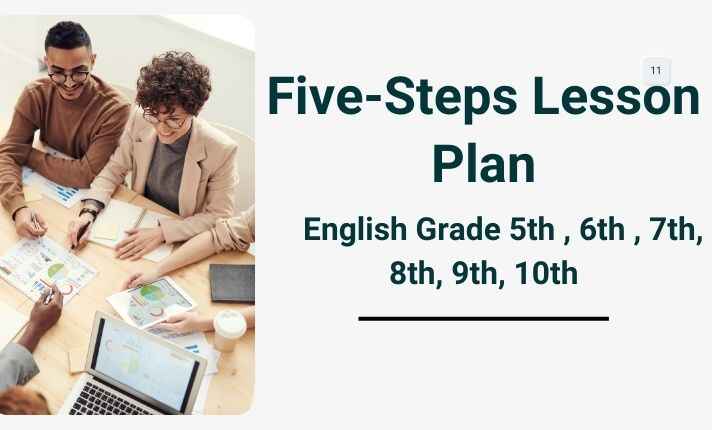Laravel Cloud: The Future of Instant App Deployment
Read More


Before stepping into the classroom, a good teacher must have planned his lesson that aligned with the student’s s big goals. Otherwise, the lesson that is taught without lesson planning will be boring and will not bear an effective outcome. Therefore, a teacher must spend time in planning the lesson.
An effective lesson plan should include five steps:
To start a lesson effectively, it's important to have a strong opening, also known as a "hook." This sets the tone for the learning experience and grabs the students' attention. You can create a compelling hook by connecting the new material to what students already know, asking a thought-provoking question, or sharing an engaging story or anecdote related to the lesson. You can also use multimedia like a short video or image, or involve the students in a quick, interactive activity to spark their curiosity and interest. Spending 3 to 4 minutes on this engaging introduction can energize your classroom and make students excited to start the lesson.
Introduction to New Material (INM) is an essential part of the lesson plan. During this part of the lesson, the teacher presents the key knowledge and skills that students need to practice and master the content. It's important for teachers to choose the information to be conveyed and the method of delivery carefully, ensuring that students remain actively engaged. The INM should also anticipate and address potential misunderstandings while incorporating strategies to check for student understanding as the lesson progresses.
In Guided Practice, students get to practice what they've learned with help from the teacher and their peers. This helps them prepare to work on their own. Guided Practice can take different forms, like working together on writing, asking and answering questions, reading with guidance, doing hands-on activities, or using worksheets. Teachers can use tools like graphic organizers, prompt cards, and visual aids to support learning. During Guided Practice, the teacher helps and makes sure everyone gets a chance to practice and learn. Good Guided Practice includes showing students what's expected, matching with the lesson's goals, starting with easy tasks and moving to harder ones, and giving students many chances to practice and feel confident.
During Independent Practice, students work on their own to show what they've learned. This helps the teacher see how well they understand the lesson. Students can work alone or in small groups, but they should all practice everything they've learned. It's important for students to get lots of practice so they become really good at the new skills. If students are confused, the teacher can help. This phase usually ends with a test to make sure students have achieved the lesson's goal. Independent Practice includes solving problems, answering questions, and doing tasks to show what they've learned. Teachers give clear instructions and make sure students focus on the main points to get ready for the test. Students might also get extra practice and challenges to learn even more.
Closing is the final part of a lesson plan and is crucial for reinforcing what was learned. It summarizes the key points and helps students understand the importance of the lesson. It is important to spend 3 to 4 minutes on this summary to ensure the objectives are clear and the significance of the material is effectively communicated.
Objective: SWBAT uses adjectives to describe people in compound sentences. (45 minutes).
Teacher stepping into the class: Good morning everyone! Woow! You all look fresh and active today. What did I just say? Who will repeat it for me?
(Expected responses from students.)
Teacher: Very good! In this sentence, I complimented you twice—once for being fresh and once for being active. Now, if you were to compliment me by mentioning two of my qualities, how would you do it? Who can raise their hand and tell me?
(Expected responses from students.)
Teacher: Ok, great, thank you! So as I used two words to compliment you ‘active’ and ‘fresh’ who can tell me which part of speech these two words belong to? (Expected answer: adjective) Yes exactly so we are going to learn how to give compliments our fellows by using two adjectives in a sentence.
Ok so first of all you need to know what is a Compound Sentence so a compound sentence is made up of two independent clauses (complete thoughts) joined by a conjunction (and, or, but). For example "She is happy, and he is sad." Check for understanding CFU: who can repeat the definition of compound sentence? good Now , come to adjectives so adjectives are words that describe nouns. They provide more information about a person, place, thing, or idea. For examples happy, sad, tall, short, funny, kind. Know we need to know one more thing that is Conjunctions: Conjunctions are words that join two sentences or clauses. In this lesson, we focus on the conjunction "and" to connect two adjectives describing a person. Example: "Sarah is funny and kind."
Alright, students, it's time for Guided Practice. Pair up with a classmate, face each other, and begin giving each other compliments using positive adjectives. Your task is to make your partner feel appreciated and valued. You have 5 minutes—2.5 minutes for each person.
As you engage in this activity, listen attentively to your partner, raise your hand if you have any questions, and participate actively. Remember, making mistakes is part of learning and improving!
For support, I will be monitoring to ensure everyone is on track and working effectively. I’ll prompt you as needed by referring back to the Introduction to New Material (INM). I’ll also provide additional help to those who need it most.
During the debrief, I will randomly ask students to share their experiences to ensure everyone has an opportunity to participate.
Ok Students, it's now time for your Independent Practice. Please write a few sentences about your best friend. If you need help translating any words into English, feel free to ask. You have 5 minutes to write as much as you can.
During this activity, please work quietly. Raise your hand if you have any questions. Once you have written 3 sentences, give me a thumbs up, and then continue writing 2 or 3 more sentences until everyone has completed their work.
Let's begin!
Alright students, let’s recall what we learned today (one student will recapitulate the lesson). Now, who would like to share what is your take away today? It can be anything from IP, GP and slo. (( taking 2 or 3 responses) Ok now, who can tell me why it is important to learn about adjectives. Expected answer:…. Great Job everyone! So our today’s class ends here I will see you all in tomorrow’s class Take good care of yourselves. Good Bye Tata
Recent posts form our Blog

.png)




pujcka na ucet
Přijetí hypoteční platby může být nebezpečné pokud nemáte rádi čekání v dlouhých řadách , vyplnění vážný
formuláře , a odmítnutí úvěru na základě vašeho úvěrového skóre .
Přijímání hypoteční platby může být problematické, pokud nemáte rádi čekání v dlouhých řadách , podávání extrémních formulářů , a odmítnutí úvěru na základě vašeho úvěrového skóre .
Přijímání hypoteční platby může být problematické , pokud nemáte
rádi čekání v dlouhých řadách , vyplnění extrémních formulářů a odmítnutí úvěrových rozhodnutí založených na úvěrových
skóre . Nyní můžete svou hypotéku zaplatit rychle a
efektivně v České republice. https://groups.google.com/g/sheasjkdcdjksaksda/c/99fiTbaaH-8